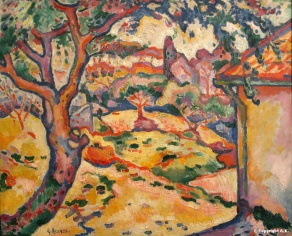Fine Art and Culinary Art have always been paired in interesting ways. The artist’s palette shows the color ingredients for the painting, while the palate of the tongue consists of your five taste sensors: sweet, salty, sour, bitter and umami or savory. Mushrooms, parmesan cheese, anchovies and olives are examples of umami—foods that also have the ability to enhance the other flavors in foods, giving them a certain fullness and roundness, a meaty quality.
I’d have to say umami is one of my favorite ‘colors’ on this palate, in a manner of speaking. And olives are one of my favorite foods. The sheer variety of color (from the ripening process), and flavor allows for the kind of nuances you might find in a Van Gogh or Monet.
Here are just a few of the many tasty varieties, each with its own character:
• Cerignola: This meaty olive is harvested in green, black and red. The green and sometimes red variety has a mild and vegetal flavor. Black cerignolas have a softer flesh, are a little sweeter, and the pit is much easier to remove.
• Picholine: French green olive, salt-brine cured, with subtle, lightly salty flavor, sometimes packed with citric acid as a preservative in the U.S.
• Kalamata: Greek black olive, harvested fully ripe, deep purple, almond-shaped, brine-cured, rich and fruity flavor
• Niçoise: French black olive, harvested fully ripe, small in size, rich, nutty, mellow flavor, high pit-to-meat ratio, often packed with herbs and stems intact
• Liguria: Italian black olive, salt-brine cured, with a vibrant flavor, sometimes packed with stems
• Ponentine: Italian black olive, salt-brine cured then packed in vinegar, mild in flavor
• Gaeta: Italian black olive, dry-salt cured, then rubbed with oil, wrinkled in appearance, mild flavor, often packed with rosemary and other herbs
• Lugano: Italian black olive, usually very salty, sometimes packed with olive leaves, popular at tastings
• Sevillano: Californian, salt-brine cured and preserved with lactic acid, very crisp
• Empeltre: These Spanish black olives are soaked in sherry
•Moroccan: a dry-cured olive, can be oil-cured or salt-cured. These shriveled black olives possess a slight bitterness and an intensity which also packs a lot of flavor in recipes.
Olive trees, one of the most often cited plants in western literature, were also a favorite subject for many artists, including Matisse, Monet, Van Gogh and others. Van Gogh painted at least 18 images of olive trees.
“In the olive trees — in the expressive power of their ancient and gnarled forms — Van Gogh found a manifestation of the spiritual force he believed resided in all of nature. His brushstrokes make the soil and even the sky seem alive with the same rustling motion as the leaves, stirred to a shimmer by the Mediterranean wind. These strong individual dashes do not seem painted so much as drawn onto the canvas with a heavily loaded brush. The energy in their continuous rhythm communicates to us, in an almost physical way, the living force that Van Gogh found within the trees themselves, the very spiritual force that he believed had shaped them.” –The National Gallery of Art
I love snacking on big meaty Cerignolas. And I enjoy a good Moroccan or Kalamata wrapped in fresh pita bread with a slice or ripe tomato, a smear of creamy French feta, cucumber and a quick drizzle of olive oil.
What are your favorite olives? Do you eat them plain, in recipes, on pizza?
Van Gogh wrote his brother Theo: “I did a landscape with olive trees and also a new study of a starry sky,” calling this painting the daylight complement to the nocturnal, Starry Night.














